In 2004, Cogent Breeding, in conjunction with Alan Whibley, now publisher of British Dairying magazine, economist Sean Rickard and global research company Kynetec, published The Sexed Semen Report. The report looked at the reason for the level of uptake of sexed semen, examined the financial implications for potential users and reviewed some of the improvements that have taken place in the use of this technology during the first few years after its launch.
Now, 20 years on, in 2024, we revisit the report, taking a look back at how perceptions have changed, and how the bovine genetics industry has benefitted from the development and advancement of sexing technology.
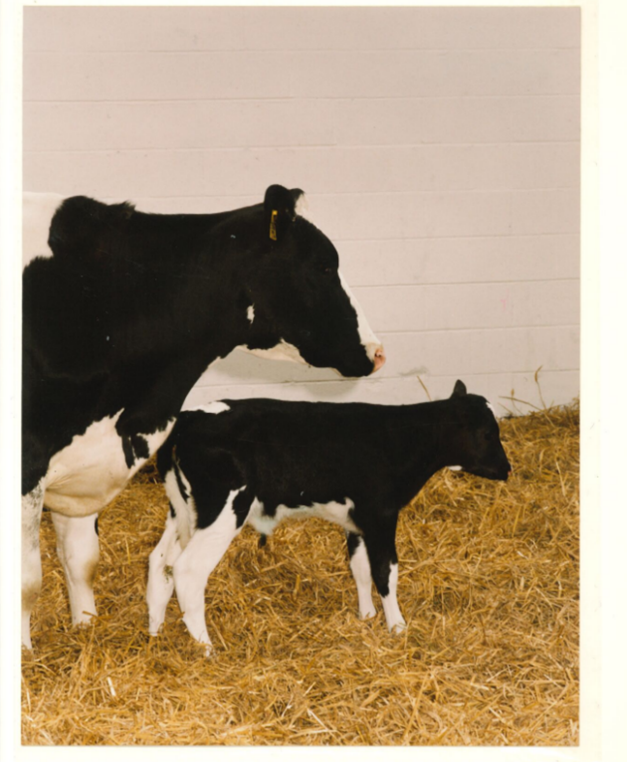
Following years of research by Cogent, the first female calf by artificial insemination with sexed semen was born in 1999 (pictured above). The 2004 report informed readers that Cogent launched sexed semen commercially in 2000, reporting that uptake in the four years following “…has so far been steady rather than dramatic,” citing the reason as “a number of years of poor profits for milk producers, coupled with concerns of its effectiveness compared to ordinary semen, and the price of the technology”.1
So, what’s changed?
Technological advancements – then vs now
The first area to explore is how the quality and performance of sexed semen has progressed in the 20 years since the report; at the time, conventional frozen semen straws contained 10-15 million sperm, while the single sex semen straw commercially available from Cogent at the time contained around 2 million sperm.
Following the launch of sexed semen, Cogent conducted trials on 162 customer farms to establish that sexed semen is comparable to conventional semen in achieving viable conception rates. In these trials, an average conception rate of 52% was achieved using sexed semen, compared to 56% conception with ordinary semen. 1
In a survey conducted by Kynetec, herds using sexed semen demonstrated average conception rates of 60% for ordinary and 54% for sexed, whereas dairy farmers who had previously tried and later stopped using sexed semen reported much lower fertility rates, averaging a conception rate to first service of 58% using ordinary straws, but only 37% using sexed semen.1
It is important to note here that the technique and timing of insemination using sexed semen is more critical when compared with the conventional product due to a process called capacitation; sexed semen has a shorter window for insemination, and should be done 18-24 hours after the onset of heat, according to Cogent.
Of course, advancements in the semen itself are thanks to advancements in technology, linked to both gender sorting and the freezing process.
SexedULTRA
For many years, the conception rate that could be achieved from sexed semen remained constant, but a breakthrough in 2015 saw an 8% gain in conception rates - see Figure 1.

While concentration rates remained the same at approximately 2-2.2 million sperm per straw, advancements in gender sorting technology resulted in the development of an improved sex-sorted product called SexedULTRA. Tests showed that SexedULTRA maintained sperm integrity better than the previous XY sorting method, with sex-sorted sperm following the SexedULTRA method resulting in a greater conception rate of 8% compared with the XY method. This new offering also boasted 90% gender purity, promising a higher possibility of female calves.
SexedULTRA4M
Two years passed, with existing technology built upon, and the sexing procedure refined to pave the way for bigger and better things. In December 2017, the acquisition of Cogent Breeding by US based ST Genetics gave Cogent customers access to SexedULTRA4M. At the time, Cogent acquired 12 new generation sorting machines, which tripled the capacity, enabling them to supply the product to the market within a few weeks.

SexedULTRA4M contained double the number of female sperm cells per straw compared with other sexed semen on the market. With further advancements and efficiencies in sorting technology and the speed in which it’s done, conception rates were boosted by a further 3%, making it comparable with conventional semen.
The boost in concentration rates from 2 million to 4 million sperm cells per straw, alongside new sperm cell medias, which enhanced the quality of the semen and its ability to get animals in calf, opened up new possibilities for the use of sexed semen on cows in the herd, not just heifers.
Ultraplus
Fast forward another few years, and in September 2022, Cogent launched its next generation of gender-sorted semen – Ultraplus. This delivered a further improvement in conception rates of 3%, comparable with the previous SexedULTRA4M, making it the highest fertility gender-sorted semen ever available.
Three years of development and farm trials were behind the launch of Ultraplus, with over 15,000 inseminations - most of which were carried out on UK farms under UK conditions. Initially only available across 90% of Cogent’s dairy offering, it is now available across all dairy sires, including a growing selection of beef sires, available in Ultraplus male sexed (more on that to follow).
Ultraplus High Purity
Going one step further than this, the improved gender purity product, Ultraplus High Purity, which has been commercially available since 2022, offers 96-97% gender accuracy compared to the 90% Cogent standard, and 85% industry standard. This elite semen product brings extreme accuracy to those who were seeking further precision, but not willing to compromise on conception rates.
Andrew Holliday, genetics manager at Cogent Breeding reflects on the advances of sexing technology and the subsequent improvements in conception rates from it’s use.
“The conception rates of the initial sexed semen straws in the early 2000s averaged 30% below that achieved by conventional semen,” he says.
“But thanks to technological developments, and particularly in recent years our access to more advanced technology through ST Genetics, results can easily match conventional success rates, at 95%+, as long as correct procedures are followed.”
(Taking a conception rate of 100% for conventional semen, the performance of sexed semen currently averages 98-100%. This relative conception rate comparison is used, as individual farm conception rates can vary widely from herd to herd, with some producers facing a fertility challenge and others achieving high pregnancy rate figures.)
“Sexed semen does remain more expensive, compared with conventional, as there is a multi-step process involved and a lot of money has been invested in research and technology, but it brings so many benefits, and has facilitated a more productive and sustainable dairy sector.”
__________________________________________________________________________________
Male sexed beef semen
With more than half of the UK’s beef now coming from the dairy herd, further breeding advances have provided an opportunity for dairy farmers to maximise their returns through targeted breeding strategies. With an increase in sexed dairy semen uptake since its launch in the early 2000s, albeit gradually, it took a while for the beef equivalent to become available.
The 2004 report highlighted the “potential higher price of calves that could be achieved from enabling a greater proportion of cows to be served with beef semen, particularly males1.” This was before the concept of beef male sexed semen was commercially available, so referred only to conventional beef semen.
In 2016, shortly before the acquisition of Cogent Breeding, ST Genetics reported on a growing interest in male sexed beef semen in the US, particularly by cattlemen producing breeding bulls. In December 2017, the first indication of male sexed semen availability from Cogent was mentioned by then managing director and now non-executive chairman of Cogent Breeding, Mark Roach, in a media interview.
February 2019 saw the launch of Cogent’s first male sexed semen product. At an entry point where technology was already advanced, and following the success of female dairy SexedULTRA 4M, Cogent transferred the technology to launch SexedULTRA 4M Beef.
At the time of launch, it was the only one of its kind produced in the UK, its commercial availability reflecting a marked industry-wide shift in attitude towards beef from the dairy herd.
In the past, beef was largely viewed as a by-product of dairying, with little thought given to the type of beef sires used. However, the development of integrated supply chains means beef from dairy units is becoming an increasingly important part of farm businesses. Dairy market volatility also means income from dairy beef is an increasingly valuable source of income.
“Male sexed semen was driven by demand from farmers and was a huge development for the industry,” says Boomer Birch.
“At the time of its launch nearly five years ago, the industry was growing massively in terms of integration, and continues to do so now. Producers and finishers are looking for animals that are more efficient to finish, either extensively or intensively, and steers and bulls deliver that, making the beef supply chain more efficient.”
Part of Cogent’s wider Beef on Dairy Programme, Ultraplus beef semen covers proven beef bulls from a range of breeds, to ensure all business models, supply chains and retailers are catered for.
Bulls have been identified to meet the needs of dairy farmers with the development of the Cogent Beef Impact index. This is made up of Ease of Management Impact (£EMI), which covers calving ease, gestation length and calf vigour, and Market Value Impact (£MVI), which includes calf quality and birthweight. A high £MVI will have a high market value and will take less time to reach optimum weight.
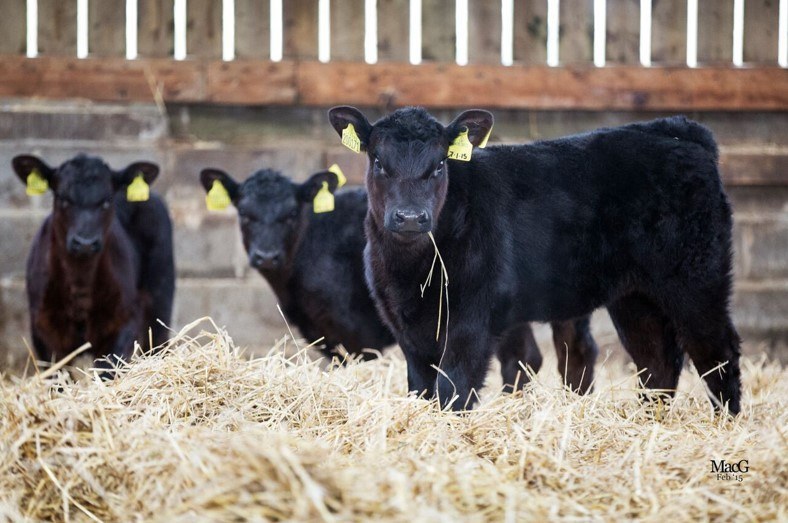
Mr Birch believes the introduction of male sexed beef semen enabled breeding strategies to become more focussed and based around understanding the genetic value of females in the herd. He advises genomically testing all heifers and first and second lactation animals, and then using this information to make breeding decisions. He suggests the following breeding strategy, outlined in Figure 2 below.
- Use female sexed dairy semen on the top 30% of females to produce replacement females of high genetic value.
- Use male sexed beef semen on the middle 20% of females that are still highly fertile.
- Use conventional beef semen on the bottom 50% with lower fertility indexes.
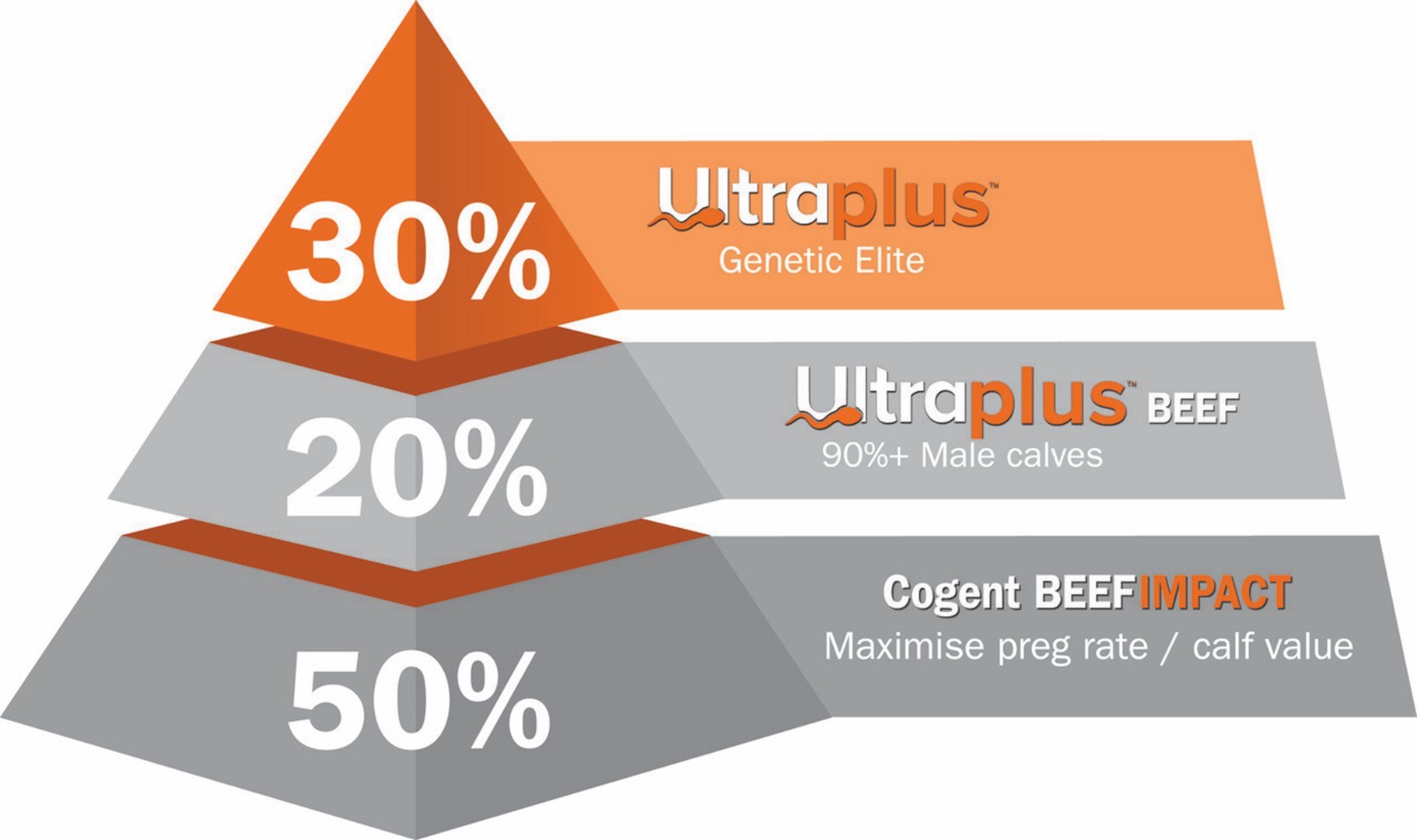
As with all sexed semen products, to get the best conception rates, Mr Birch suggests it is best to only serve high fertile animals. All the basics of good breeding management and best practice semen handling practices also apply in order to achieve good conception rates.
__________________________________________________________________________________
Industry uptake of sexed semen
In July 2023, the AHDB survey of breeding companies revealed a substantial increase in the adoption of sexed dairy semen3, with data collected over the 12 months prior to March 2023. Sales of sexed semen increased to 76.5% of all dairy semen, marking a notable increase from 70% in 2022, consistent with the increase from 2021 to 2022. Elsewhere, data from the same survey indicates that beef semen sales to the dairy herd have risen to 49%, up from 48% of total sales in 2022.
Cogent Breeding genetics manager Andrew Holliday reports that, as of January 2024, Cogent only sells 3% conventional semen from dairy sires, a higher percentage of sexed than the industry average.
AHDB data for sexed semen sales only begins in 2012, as per Figure 3 below, when sales of sexed semen accounted for only 12.3% of all dairy semen. Since 2012, uptake was steady for the five years up to 2017, followed by a sharper increase each year from 2018 onwards. AHDB implies the increased confidence among farmers in sexed semen has driven the upward trajectory, and links it to the industry's continued focus on promoting the Dairy Calf Strategy priorities.
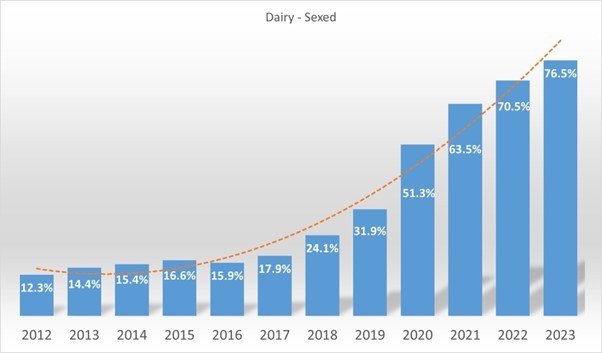
In September 2018, Cogent launched a breeding plan that used only sexed dairy semen and quality beef semen. ‘The Ultimate Breeding Strategy - Meeting the future supply chain requirements for the profitable dairy herd,’ highlighted the growing need for dairy farmers to consider the benefits of a new targeted breeding policy.
With contributions from the NFU, Marks & Spencer, Arla Foods UK, AHDB Dairy, The Buitelaar Group, LLM Farm Vets and Kite Consultancy, it highlighted the significant benefits of this approach to herd reproduction and highlighted the role of the breeding policy in meeting the changing needs of the modern supply chain.
At the time, the industry was making an increasing effort to protect its image, and stakeholders at all levels of the supply chain realised they were much stronger as an industry if positive working relationships were developed throughout the chain. Retailers and milk buyers wanted to work more closely with farmers to address sustainability, and all acknowledged that they needed to adapt and accept new practices and new technologies that improve efficiencies.
“The welfare issue linked to the production of dairy bull calves was one of the main drivers for the spike in popularity in around 2019,” says Mr Holliday.
“Some milk buyers began stipulating practices for bull calves from the dairy herd, so producers had little choice but to turn to sexed semen. The knock-on effect is a rise in male beef semen and now over 50% of our current sales are for beef on dairy.”
Has the GB Dairy Calf Strategy 2020-2023, cited as a potential reason for increased uptake of sexed semen by AHDB, had a substantial impact on the breeding decisions of the British dairy industry?
The strategy, which is supported by 44 industry organisations including retailers, processors, membership organisations, genetics companies and assurance schemes, identifies where the potential and responsibility exist for further improvement in the supply chain. It highlights the top priorities, some short-term and some medium-term, and the actions required to achieve them4.
Actions include:
- Dairy farmers to demonstrate commitment to reduce the number of economically unviable calves through responsible breeding strategies
- Promote better breeding tools and techniques such as the use of sexed semen
- Maximise the use of beef cross-breeding in the dairy herd to increase the potential value of the resulting calves
- Ensure calf specifications are known and communicated to dairy farmers so they can breed suitable calves for the beef supply chain
- Collaboration across supply chains to develop new opportunities for dairy and beef bred calves, linking milk and beef supply chains
Changing attitudes towards sexed semen
Research conducted for the 2004 sexed semen report showed that the principal reason for not adopting sexed semen use on-farm was that, in their eyes, it remained unproven, as well as the high cost of the product.
Less than 8% of the respondents dismissed the technology outright as being “too unreliable.” 14% were actively considering using it and a further 4% said they were definitely going to use it in the future. Elsewhere, sexed semen was seen as not being relevant to the businesses of one in three of the respondents, who were either happy using their own bulls, or saw no gain to be had by controlling the number of heifers produced by the herd.
At the time of the report, Cogent were only offering sexed semen straws from six of its dairy bulls, with some farmers saying that limited bull choice was the reason for not using sexed semen. Others claimed they were too busy to use sexed semen, and a further group said they had never heard of it, despite it being actively used on British farms for over four years.
Generally, while minds were generally not closed to the new technology at the time, they required hard evidence that its use could justify the cost. And while many farmers liked to be seen as innovators, those surveyed preferred to know someone else was using it, or would recommend it first, before trying it themselves.
So was it the building momentum of trust amongst fellow farmers which created the turning point in 2018, or was it the advancement in technology providing higher concentration sexed semen, with promised improved conception rates, or perhaps the collective industry approach? Perhaps a combination of all of the above?
It should also be considered that genetics companies have also worked hard to communicate its benefits, financial and otherwise. Engaging the services of PR and marketing teams to demonstrate the results that can and have been achieved in a real farm setting, the topic has been covered in depth in the farming media, and at industry events, and let’s not forget the rise of social media since 2004!
Now, twenty years on, industry sales figures speak for themselves, and dairy farmers are proud to share their breeding successes. Cogent customer Kevin Jones and son Steffan of Talfan Farm in St Clears, South Wales, milk 170 cows, with 150 followers, providing milk to Müller. They started using sexed semen as part of their breeding strategy in 2013.
“Ten years ago we made the switch from conventional semen to Cogent sexed semen. We could see the benefits and the value it could add to our business, and we haven’t looked back,” Kevin explains.
“Our conception rates are equal to that of conventional semen and we are receiving higher market prices for our Cullard Charolais X beef calves compared to the Holstein bull calves, which has increased profitability.”
Over the past few years Kevin, Steffan have embraced more of Cogent’s services. Working with genetic consultant Sian Jones, they have started chromosomal mating their cows and heifers to positive results.
“Not only are our youngstock more balanced and uniform, the results are showing in the animals entering the herd, with increased milk, butterfat and protein, and fertility and longevity is increasing on our herd report.”
__________________________________________________________________________________
Economic and genetic impact
The 2004 report identified the benefit of sexed semen in producing high value cross bred animals, as well as the potential genetic improvement to the herd and greater control over herd replacements. Economist Sean Rickard estimated that milk production could be improved by around 15%.
Financially, the report highlighted the potential economic gain to farmers – largely focussed on conception rates, and the cost of sexed straws vs conventional, it suggested an increase in gross margins of around 21%, equating to £350 million based on the number of dairy farms in the UK at the time.
Alongside the tangible product, advances in other breeding services, such as Cogent’s herd analysis tool PrecisionMAP, can help farmers understand the true impact of a more targeted breeding strategy.
For example, one Cogent customer, milking 133 Holstein cows, used this tool to calculate the ROI of adopting a sexed-beef strategy for his herd. Based on a 20% replacement rate, and a conception rate of 45%, he requires 30 replacements.
With additional semen costs of £4509, the value of better genetics entering the herd due to more targeted breeding is £7,655, and the value of his calf crop increases by £32,980, based on a £375 beef bull, £300 beef heifer, and a £50 beef calf. That’s a total ROI of £36,126.
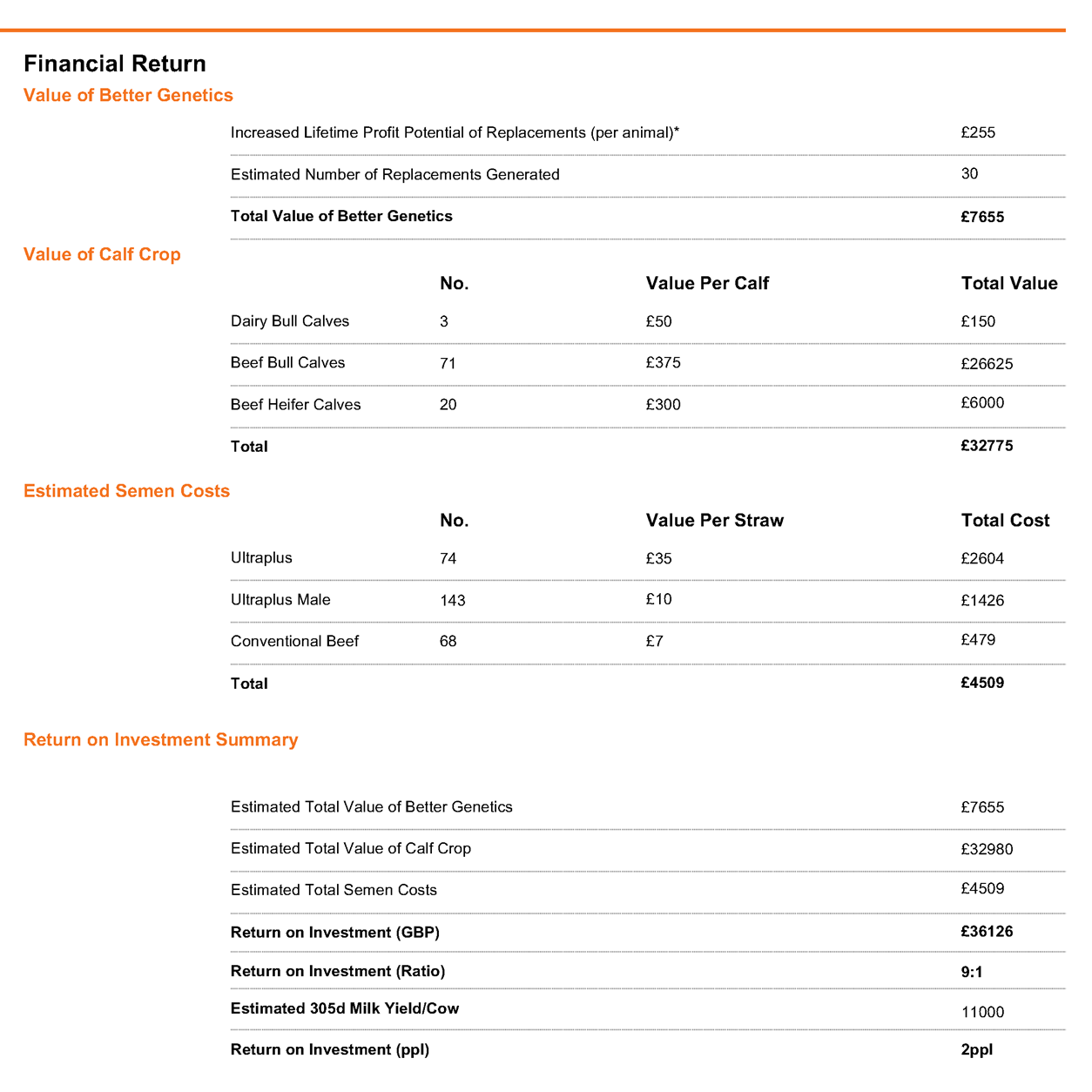
“The clear benefit here is the return on investment of 9:1,” explains Will Barber, Holstein product manager at Cogent.
“By using both dairy and beef sexed semen, farmers can gain in two ways – economically, and also genetically, through the clever application of a targeted strategy. For me, it’s about helping and enabling dairy farms to operate profitably and sustainably.
“We’ve been working towards this point since 2004, and the rapid adoption of this technology across the industry is encouraging. Herd sizes have obviously grown, and farms are benefitting from increased income and performance, and surviving where not previously possible had they remained using conventional semen.
“There’s still some way to go, and while the number of British dairy farms has unfortunately dropped, we continue to see growth in overall milk production. This is a testament to the industry's commitment towards modern and sustainable adoption of technology, something we're poised to demonstrate benefits an integrated approach and, together, can secure the survival, success and future of individual dairy businesses and, subsequently, the British dairy industry,” he adds.
Future industry developments
So, where next? And why is the role of sexed semen and targeted breeding more important today than it ever has been?
A growing population, and a growing demand for milk and dairy products, with a falling number of British dairy farms means those in operation need to operate efficiently to survive, and also make the most of the opportunities available.
The demand for beef from the dairy herd is also growing, with processors seeking top quality crossbred calves rather than dairy bull calves, and animal health and welfare continues to be a priority for the consumer and retailer.
With over two decades of experience in sexing semen, Cogent offers the most comprehensive list of bulls available sexed, catering to the dairy and beef markets. Cogent and St Genetics’ progressive technology brings Ultraplus to the commercial market, which, twinned with a targeted breeding strategy, and best practice on-farm application, helps make The Cogent Difference.
Cogent Breeding continues to work alongside dairy and beef producers to develop its technology and improve accuracy.
“We’re aiming for Ultraplus High Purity, which provides 96-97% gender accuracy, to become the norm,” reveals Mr Holliday.
“In time, I firmly believe all semen sold into the sector will be sexed semen,” he adds.
“Farmers will use sexed female for their replacements, and sexed male to produce calves for the beef industry. Sexing technology has the potential to make conventional semen obsolete, as one sex will always be more valuable than the other, depending on the goal.
“It’s up to us to continue producing a wide range of high-quality, high-performance genetics for the industry, to not only secure its future, but help it to thrive” he concludes.
- ENDS -
__________________________________________________________________________________
1 2004 Sexed Semen Report, Grove House Research, 2004.
2 SexedULTRA™, a new method of processing sex-sorted bovine sperm improves conception rates, R. W. Lenz, C. Gonzalez-Marin, T. B. Gilligan, J. M. DeJarnette, 2015.
3 Survey reveals significant increase in sexed dairy semen, AHDB, 2023
4 GB Dairy Calf Strategy 2020 - 2023